Intel Unveils Moorestown and the Atom Z600, The Fastest Smartphone Platform?
by Anand Lal Shimpi on May 4, 2010 11:54 PM EST- Posted in
- Smartphones
- Intel
- Atom
- Mobile
- SoCs
Moorestown: The Two Chip Solution That Uses Five Chips
Intel calls Moorestown a two-chip solution. That’s the Lincroft SoC and the Langwell IO Hub. Intel says there’s no architecture limitation for splitting these two up, it was just a way of minimizing risk. You put the bulk of the 3rd party technologies in the Langwell IO Hub and keep the important, mostly Intel controlled components in Lincroft. This is still the first SoC that Intel is going to market with, so splitting the design into two chips makes sense. The followon to Moorestown, codenamed Medfield, will integrate these two once Intel is comfortable.

The 45nm, 140M transistor Lincroft die
Lincroft houses the CPU, GPU and memory controller and is built on Intel’s 45nm process. This isn’t the same 45nm process used in other Intel CPUs, instead it’s a special low power version that trades 6 - 8% performance for a 60% reduction in leakage. The tradeoff makes sense since the bulk of these chips will run at or below 1.5GHz. And by the way, it’s now called the Atom Z600 series.
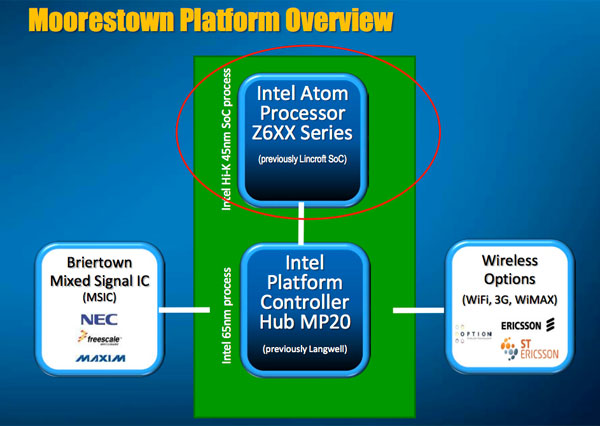
| Transistor Comparison | |||||
| Intel Atom Z5xx Series | Intel Atom Z6xx Series | NVIDIA Tegra 2 | |||
| Manufacturing Process | 45nm | 45nm | 40nm | ||
| Transistor Count | 47M | 140M | 260M* | ||
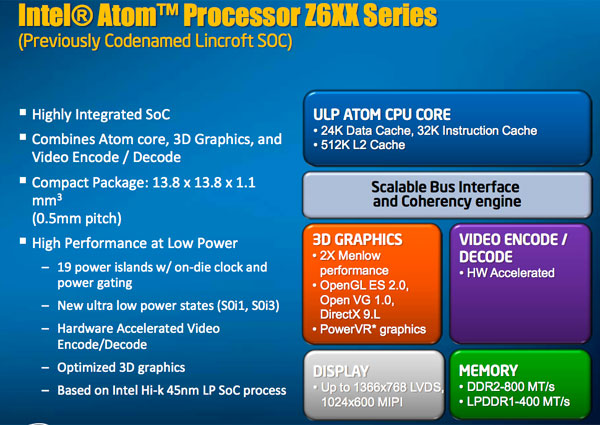
Langwell, now known as the Intel Platform Controller Hub (PCH) MP20, holds virtually everything else. It’s got an image processing core that supports two cameras (1 x 5MP and 1 x VGA), USB 2.0 controller, HDMI output (1080p) and a NAND controller that can support speeds of up to 80MB/s. The whole chip is managed by a 32-bit RISC core.
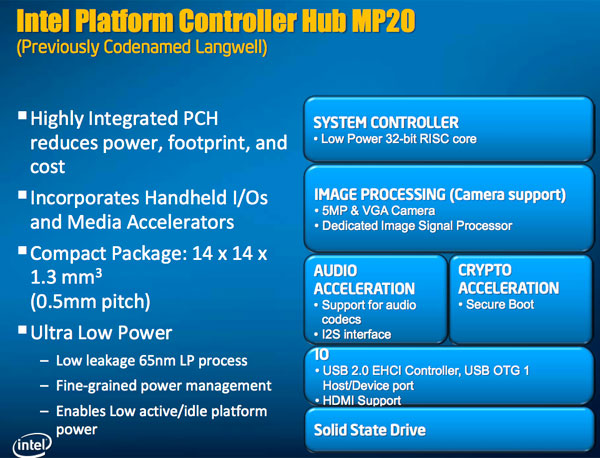
Langwell is a 65nm chip built at TSMC. TSMC has existing relationships with all of the IP providers for the blocks inside Langwell, so making it at TSMC is a sensible move (a temporary one though, with Medfield Intel will integrate all of this).
and_PlatformControllerHub_package2_sm.jpg)
Langwell (left) and Lincroft (right)
While Lincr, err, Atom Z600 and the Intel PCH MP20 are enough for a traditional system, they are not enough for a smartphone. You need wireless radios, that’s one chip for WiFi and one for 3G support. You need something to handle things like power management, charging the battery and controlling the touch screen. That’s an additional chip, called Briertown.
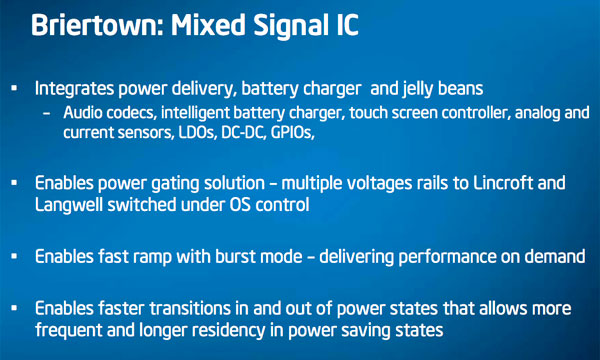
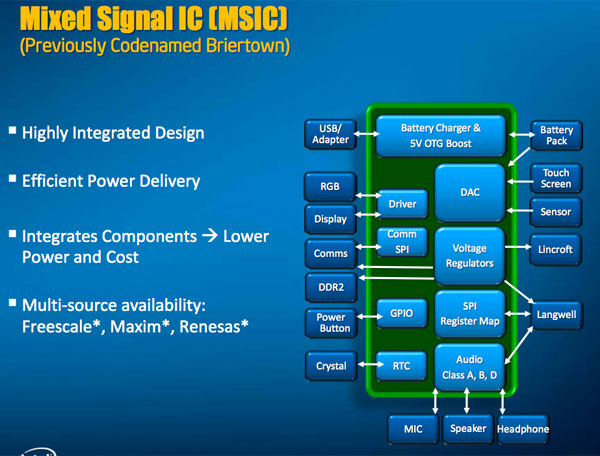
We’re up to four chips at this point, but you need at least one more. While modern day smartphone SoCs ship with on-package memory, Intel doesn’t yet support that. Obviously it’s not impossible to do, Marvell, TI, Qualcomm and Samsung do it with all of their SoCs. Look inside Apple’s iPad and you won’t see any DRAM chips, just a Samsung part number on the application processor package. Intel doesn’t have the same experience in building SoCs and definitely not in integrating memory so it’s not a surprise we don’t have that with Moorestown. Unfortunately this means a smartphone manufacturer will need as many as five discrete chips to support Moorestown.
| Platform Size | |||||
| Moorestown | |||||
| CPU + Chipset | 387 mm2 | ||||
| Total Platform Area | 4200 mm^2 | ||||
| SoC Package Size | 13.8 mm x 13.8 mm x 1.0 mm | ||||
| PCH Package Size | 14 mm x 14 mm x 1.33 mm | ||||
And now we know why Intel has been showing off its extremely long form factor prototype all this time:
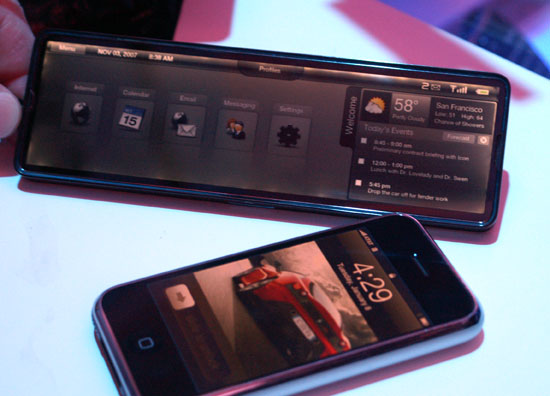










67 Comments
View All Comments
strikeback03 - Wednesday, May 5, 2010 - link
No, I think he is asking for Windows 7, not Windows Phone 7. WHich I can see being useful on a tablet, but not at all on a phone. It would take so much effort to turn the standard version of Windows 7 into something usable on a phone that I would imagine if x86 does take off in smartphones Microsoft would be better off just making a completely new OS that can run windows programs.logdrum - Saturday, November 20, 2010 - link
There are Moorsetown tablets running Windows 7, As long as the chipset has a PCI bus Windows 7 heck even Windows 2003 server shuld install. The smart phone do not have a PCI bus therefore you cannot install Windows 7logdrum - Saturday, November 20, 2010 - link
It is not a limitation of x86. Windows needs a PCI bus to install and run. There is no PCI bus in Intel embedded systems or ARM for that matter. Having said that you can install VMware on the Linux OS and install Windows as a Virtual Machine. Some people even say hacking the firmware of the embedded hardware to fake a PCI bus so Windows would install. It could be done. Take one of those WindRiver classes on fastboot and kboot and maybe you could make it happen.logdrum - Saturday, November 20, 2010 - link
I am talking here purely x86 Windows, the one on desktops and netbooks and even tablets. Tablets have a PCI bus usually. The phone factor of Moorsetown does not have,jaydee - Wednesday, May 5, 2010 - link
Dual-boot Windows 7 and Android on a 10" tablet. Please?arnavvdesai - Wednesday, May 5, 2010 - link
I think getting 3 out of 5 will be very hard for Intel, especially Apple because that company has sunk so much of its own money into chip IP. Apple is not content with just getting the best hardware out there in ARM world but wants to actually design the chip around its own OS so I dont see them using the Atom series.Intel says Win7CE & Win8CE are both out so that leaves them in a bad place. However, Microsoft is working on a micro OS kernel inside its labs called Menlo( I am not sure about the name) which Intel could try and effectively market to. Basically in Menlo Microsoft is trying to shrink NT to super small size and footrpint.
DanNeely - Wednesday, May 5, 2010 - link
Intel offered the ability to create custom atom SOC's via TSMC fabs about a year ago. It was withdrawn due to lack of interest; but if apple was interested I'm certain they'd make it available again.aguilpa1 - Wednesday, May 5, 2010 - link
People will forgive lots of things if the thing just looks HOT and works as it should. It has been a long time since I have been wowed by any of the new smartphone devices, including the iphone. It is sleek and well built but a little to chunky and roundish for my taste. However they get the style look down.geniekid - Wednesday, May 5, 2010 - link
Would it be possible to leverage Moorestown in a way that yields 2x the battery life with the same performance as today's top end smartphones? Most 3GS/N1 users today would rather have more battery life than HD playback ability. Unfortunately, as I think about it, I believe that the battery sucking features of the phone are the peripheral devices - wifi/3g radio, camera, display, things which are outside the scope of Moorestown.Mike1111 - Wednesday, May 5, 2010 - link
If the Z600 only support 1024x600 or higher, how come the Aava reference platform has 800x480?And even though I think the performance is very good, Z600 is still too big to compete in the Smartphone market (3-4 chips instead of 1)? I don't see how that could work with something as small as the iPhone 4th-gen's mainboard, which is incredible tiny.
Also Intel talks about combining Lincroft and Langwell into one chip, but no official word on memory in the same package? Only Anand speculates about it.
But if they Intel can integrate at least these three chips into one package with Medfield and offer some additional improvements plus @32nm, and have actual Medfield smartphones on the shelves by the holiday season 2011, Intel can finally start to compete in the smartphone market.